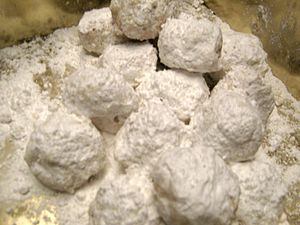- Russian tea cake
-
A Russian tea cake is a kind of pastry, commonly eaten around Christmas in both Russia[verification needed][citation needed] and the United States. It is a form of jumble, a pastry common in Middle Ages England. They are also known as Mexican wedding cakes (or cookies) and butterballs.
Ingredients
Russian tea cakes have a relatively simple recipe, generally consisting entirely of ground nuts, flour and water or, more commonly, butter. After baking, they are coated in powdered sugar while still hot, then again once the cookie has cooled.[1]
History
Russian tea cakes appeared in Russia in the 18th century as a confection used in a tea-sharing ceremony. By the 20th century, they were a part of wedding and Christmas traditions in the U.S., known by their popular "Russian tea" name. Mexican Wedding Cookies, and Bizcochitos, the official cookie of the State of New Mexico, are similar except that they have the addition of anise, although, properly made, the anise flavor is very mild. Many cultures have a similar cookie. In Spain, they are called Mantecosos.
References
- ^ Food Lover's Companion, Sharon Tyler Herbst, 3rd edition [Barron:New York] 2001 (p. 385)
Categories:- Cookies
- Christmas food
- Dessert stubs
Wikimedia Foundation. 2010.

